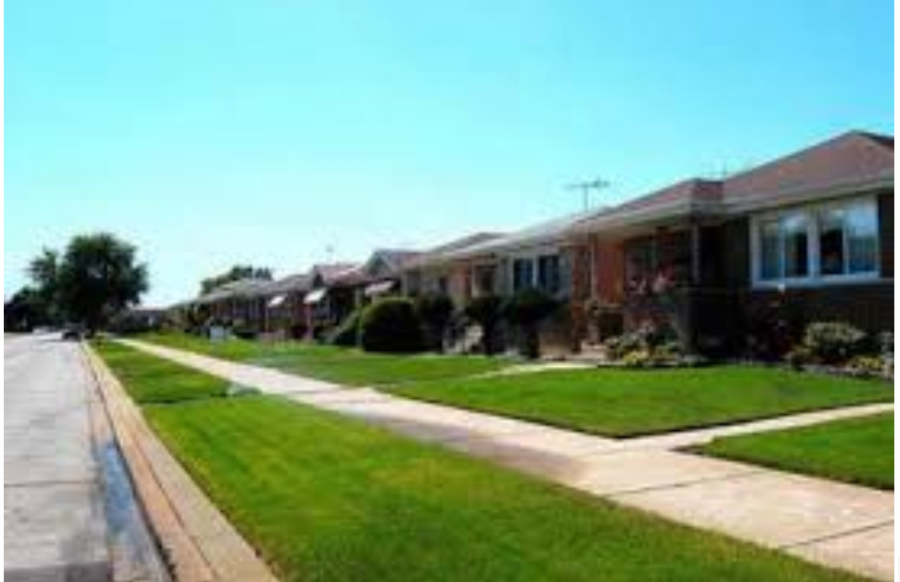We’ve all been there. It’s a Saturday morning, the sun is shining, and you’re just waking up. What do you hear? Unfortunately, the sound is not birds chirping outside your window, but rather your neighbor mowing their lawn at 7:30 am… again. Of course, it’s not very pleasant having to wake up on a Saturday morning due to the noise of a motor, nor is it pleasant mowing the lawn in the heat and humidity, but the average grass lawn is found expanding across miles of urban and suburban communities. Despite these setbacks, there are many more problems surrounding this cultural norm than just the sound or the work.
The first grass lawn was found in the garden of Versailles, constructed under the command of King Louis XIV. There were many things built during his reign in the garden of Versailles: the Orangerie, Ménagerie, and the Grand Canal. Much of what was built during this time reflected Louis’s immense power, and in Versailles, the king was able to control this small but rapidly growing piece of earth. Villages, as well as parishes, evaporated to make room for the expanding garden, and the best architects, landscapers, and sculptors of the country were brought to this place to try and satisfy the desires of the king. In a book written by a gardener for Versailles, he sums up Louis XIV’s aspirations: “Domination through aesthetics was perhaps the greatest exploit of the reign of Louis XIV… The gardens were an excellent means for demonstrating power” (Baraton, 80-81). The grass lawn, which could be trimmed perfectly and fit any geometric shape or pattern, was a perfect fit among other various vegetation found in what used to be a simple 7-acre forest with a vegetable patch. Though wide expanses of grassland were nothing new, they were usually used for grazing animals, or in a way that somehow benefited the people on the land. The lawns of Versailles, however, were not cultivated so that sheep could prance upon it: they were simply there as a status of the king’s wealth and domination of the land.
Though having something that serves no purpose seems redundant and impractical, the lawns did in fact serve one purpose that benefited the king: they showed status. No one else who owned an expanse of land that was just grass also had the necessary laborers to trim it– most had livestock. Though it may seem that only Louis XIV would have benefited from grass as a status symbol, an example of status portrayed through lawns can also be found in The Great Gatsby by F. Scott Fitzgerald. In the scene where Gatsby comes over the day before Daisy arrives at Nick’s house for tea, he takes a minute to point out Nick’s lawn: “We both looked at the grass: there was a sharp line where my ragged lawn ended and the darker, well-kept expanse of his began.” (Fitzgerald, 82). Though the suggestion seems off-hand, the lawns portray Gatsby’s immense wealth and how his status allows him to have the means to take care of his own large garden, whereas “small” Nick does not have the time or money to, nor does he have the money to hire those who can properly trim his grass.
The fact that lawns are still used as a status symbol of those who can dominate land is not the biggest issue regarding these plots of green, it is the fact that by cultivating it, we are cultivating vegetation that serves no real purpose in the environment. Just by having a lawn, we deem ourselves worthy of knowing what is or is not suitable for the lawn. A perfect example of this is the term “weeds”. To put it simply, there is no such thing as a weed. Dandelions, crabgrass, and creeping Charlies are not weeds. They are herbs or different species of grass that we have found “too pesky” to be mixed with our lawns. In fact, dandelions have more value nutritionally and medically than grass does. If you live in a state that is much drier (Texas, California), a lawn only acts as a sponge for water– simply to keep it well kept. Another, and more important point, is the fact that we could use these spaces for lawns to grow native fauna and flora. Some endangered plants found here in Minnesota include the prairie bush clover, dwarf trout lilies, and western prairie fringed orchids. Just by looking at Minnesota’s DNR page and becoming more familiar with the plethora of natural wonders in our state, we can do so much to help protect and preserve vegetation that has been here for thousands of years. Another alternative includes creating gardens in which people can grow food and put the money previously spent on seed, weedkillers, gas, and oil for the mower into a more beautiful and environmentally helpful patch of land.
As we begin to pick out vegetables to grow in our gardens and flowers to line our front walkways this spring, keep in mind that though we have the power to dominate land and earth, we also have the power to help the land and earth as well.
Sources Cited:
Baraton, Alain. “Strolling Through the Past.” The Gardener of Versailles: My Life in the World’s Greatest Garden, Rizzoli, New York, 2014, pp. 80–81.
D’Costa, Krystal. “The American Obsession with Lawns.” Scientific American Blog Network, Scientific American, 3 May 2017, https://blogs.scientificamerican.com/anthropology-in-practice/the-american-obsession-with-lawns/.
“Rare Plants, Animals, and Natural Features.” Minnesota Department of Natural Resources, https://www.dnr.state.mn.us/eco/rare.html.
Staff, Landon Iannamico |, and Landon Iannamico. “Why Do We Have Lawns Anyway? (and What We Can Do Instead).” The Daily Californian, The Weekender, 26 Mar. 2021, https://www.dailycal.org/2021/03/20/why-do-we-have-lawns-anyway/.







